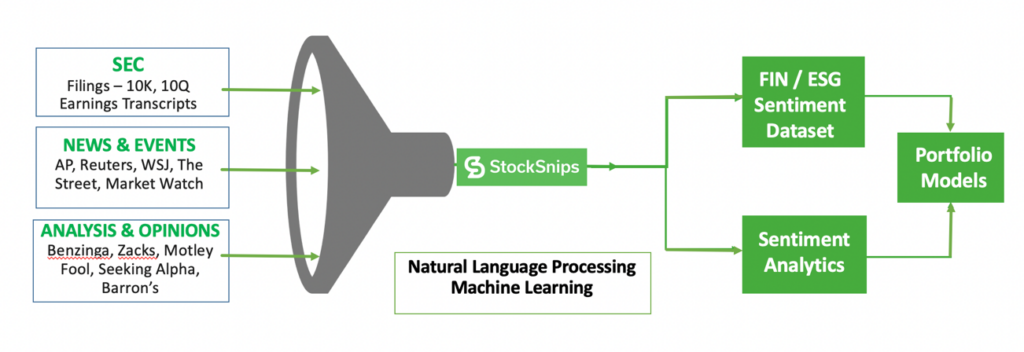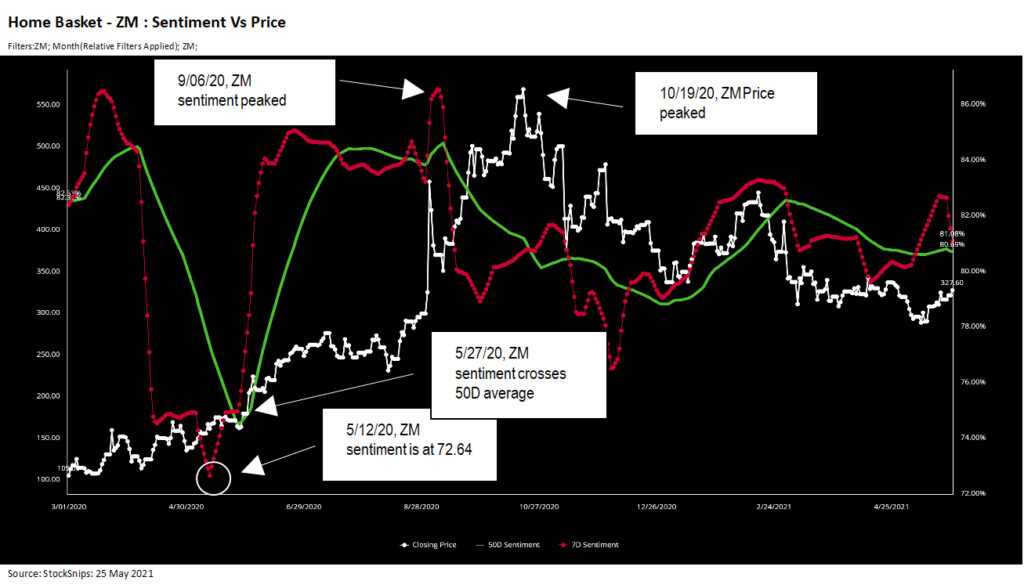Abe Cofnas, Senior Sentiment Analyst
One of the lessons of the Covid-19 pandemic is that it was much more than a public health crisis. It also generated a contagious shockwave of uncertainty and fear within economies and markets. It was an emotional event. We all recognized that markets were in the grip of fear, causing investor herding behavior that can overwhelm expected risks and returns. Yet, few fundamental and quantitative Asset Managers, as well as RIAs, actually include sentiment as a direct factor in their stock selection or portfolio construction. This is understandable as they rely on well accepted principles of Financial Mathematics to design their portfolio models. Fundamental and quantitative managers focus on Growth, Value, Quality, and Momentum as key factors generating Alpha. As a result, Black Swan events like the pandemic get absorbed and expressed through technical measures of risk and volatility. This vantage point is, however, passive and looking backwards. Hindsight, of course, provides clarity. Yet the key question is: Can portfolio results improve by early direct measurement of sentiment? This article offers some insights into this key question by providing an overview of how Artificial Intelligence/Machine Learning (AI/ML) can track investor sentiment.
The Pandemic and the Market
The pandemic shock wave generated a new and fear dominant sentiment wave that became an economic narrative: A Stay-At-Home sentiment. RIAs and Asset Managers faced an unprecedented challenge to rebalance their portfolios to reflect the right proportion of stay-at-home companies . Companies such as Zoom, Neflix became part of a Stay-at-Home basket. Cirrus Research, in fact, carefully constructed a Stay-at-Home Basket. The challenge became when to detect an end to the Stay-at-Home shockwave and revisit portfolio baskets. Not an easy task. The Pandemic collapse put new risks on existing portfolio models and new pressure to achieve Alpha. Would sentiment-tracking aid in the important decisions to rebalance a portfolio? Artificial Intelligence and Machine Learning (AI/ML) provides unprecedented tools to meet these challenges. Let’s take a closer look.
Key Steps in Using Artificial Intelligence and Machine learning, (AI/ML)
Sentiment, for the purpose of market analysis, is defined as investor sentiment. It is tracked by scanning millions of SEC filings and financial news publications. The scanned documents are then scored as to whether the documents are bullish or bearish in their bias. Using Natural Language Parsing (NLP) and financially trained Machine learning models, the text of each document is parsed for snippets attributed to companies that represent a positive or negative emotion. Such algorithmic methods have learned, by examining over 15 million documents, how to accurately attribute and devise a sentiment score. A technical term for this type of lexical analysis is Sentiment polarity. The result is a per-day sentiment score for a listed equity. Given the needed scale and frequency, no humans can achieve this kind of analysis. Also, existing portfolio construction models do not use or measure such investor sentiment. Over time, sentiment changes begin to surface, first in the news, and then correlate to changes in price.
The infographic below summarizes the key steps of the AI/ML process, from the source documents to building sentiment-based portfolio models.

ZOOM and the Sentiment Wave
During the pandemic and the subsequent lockdowns, the company ZOOM(ZM) became an iconic example of the Stay-at-Home sentiment. The need for virtual based business naturally led to the surging demand for ZOOM’s technology. The ZM price rise was clearly riding on the Stay-at-Home sentiment wave. We didn’t need any advanced algorithms to feel this sentiment. However, let’s briefly see how the equity ZOOM (ZM) looks from the vantage point of being able to track sentiment versus price. Did the sentiment reveal shifts in the Stay-at-Home emotion? Does this sentiment tracking give us an edge in predicting the price action?
We see in the chart below that sentiment is measured as a percentage. We have a 7 Day and 50 Day sentiment moving averages versus Price chart. Remember that these Sentiment scores are the results of the AI/ML scoring of sentiment expressed in the thousands of investor news stories each day. If ZOOM is mentioned in any of the documents, the relevant phrases (snippets) are extracted and their sentiment score is generated. Keep in mind that noisy sources such as social media are not part of the news sources analyzed.

The main point in looking at the sentiment versus ZOOM price action example, is to see that sentiment direction and changes in sentiment direction often precede price action.
Zoom sentiment was at a low of 72.64 on May 12, 2020 and ZM price was at $161.04. Sentiment crossed over its own 50D moving average on May 27, 2020 (75.20) and ZM price was at $163.35. From that point in time, Sentiment entered a nearly parabolic growth. Without any sign of Bearish sentiment, ZM continued to rise. Interestingly sentiment peaked on Sept 6, 2020 at 86.50. The ZM price peaked on Oct 19, 2020 at $568. Sentiment was at that point down to 80.70.
Tracking the sentiment conditions of ZM provided extra confirmation during the initial bullish phase, and generated an early warning of an impending bearish turn as sentiment first peaked and then shifted down. ZM subsequently moved away from its highs and began declining in price.
A powerful application of sentiment tracking is the ability to generate sentiment measures for an entire basket! This will enable more timely rebalancing of portfolios to reflect new shifts in market sentiment.
Evidence of Excess Double-Digit Alpha Using AI/ML Algorithmic Methods
Is there evidence that adding sentiment as a factor in portfolio construction can achieve Alpha? The answer is yes. Cirrus Research tracked the net gains using news sentiment and achieved 93% gain vs a 69% market benchmark over a 3-year period. As a result, Cirrus’s Aggressive Growth model was replaced with the Stocksnips Big Data model. In recent months, several seed portfolios using the AI/ML sentiment methods are now operating. (Insert Link to Cirrus Study)
Conclusion: Sentiment is an Alternative Factor in the Search for Alpha
With recent advances in AI/ML, portfolios can become more forward looking by directly including investor sentiment as a construction factor. By detecting and riding the sentiment waves, a new powerful factor potential for obtaining excess Alpha can be added to the standard toolkit of the Asset Manager. It makes sense to get sentimental.